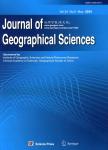Comparison of channel geometry changes in Inner Mongolian reach of the Yellow River before and after joint operation of large upstream reservoirs
Comparison of channel geometry changes in Inner Mongolian reach of the Yellow River before and after joint operation of large upstream reservoirs作者机构:Key Laboratory of Water Cycle and Related Land Surface Processes Institute of Geographic Sciences and Natural Resources Research CAS Beijing 100101 China University of Chinese Academy of Sciences Beijing 100049 China
出 版 物:《Journal of Geographical Sciences》 (地理学报(英文版))
年 卷 期:2015年第25卷第8期
页 面:930-942页
核心收录:
学科分类:081504[工学-水利水电工程] 08[工学] 081502[工学-水力学及河流动力学] 0815[工学-水利工程]
基 金:National Natural Science Foundation of China, Grant No.41271027 National Basic Research Program of China (973 Program), No.2011CB403305 fund from the Ministry of Science and Technology of China, No.2013DFA91700
主 题:channel cross-section shape parameters change rate reservoir joint operation Yellow River
摘 要:The impact of reservoirs on downstream river channel change has been a scientific issue in fluvial geomorphology during the last few decades. However, it is still a difficult issue as to how to express quantitatively the channel adjustment in the Inner Mongolian reach of the Yellow River induced by the joint operation of upstream reservoirs. Based on the shape parameters of channel cross-sections at four gauging stations in this river reach over a flooding season in two periods, 1978–1982 and 2008–2012, the present work investigated the channel changes in terms of shape parameter change rate under the same controlling water level in each flooding season at the channel cross-sections. Results showed that most of the change rates of the parameters evidently increased over a flooding season in both periods. However, the change rate of each parameter at the cross-sections decreased evidently in the latter period, compared with the former period. At the same time, the distribution pattern of the change rate of the shape parameters along the cross-sections thus changed from a convex curve in the former period to an S-shaped curve in the latter period. The obvious decrease of the change rates is related to the joint operation of the Liujiaxia and Longyangxia reservoirs. The reservoirs stored a large volume of water and decreased the peak discharge and maximum velocity in the flooding season; as a result, the erosion ability of the flood decreased accordingly. With the joint operation of the large reservoirs, the Inner Mongolian channel shrunk markedly. Therefore, the channel will present the possibility of an extreme flood in the future. Consequently, it is reasonable to adjust the function of the reservoirs in future. The total water and sediment discharges and the peak discharge in flooding seasons should be effectively controlled. Continuous shrinkage of the channel can thus be avoided and it can be ready for a potential extreme flood.



